If you’ve been doing any research on ducks lately with the hopes of getting your own flock, you might feel a little left out if you’re anything like me. That’s because most of the info out there concerning them is oriented towards production: meat and eggs!
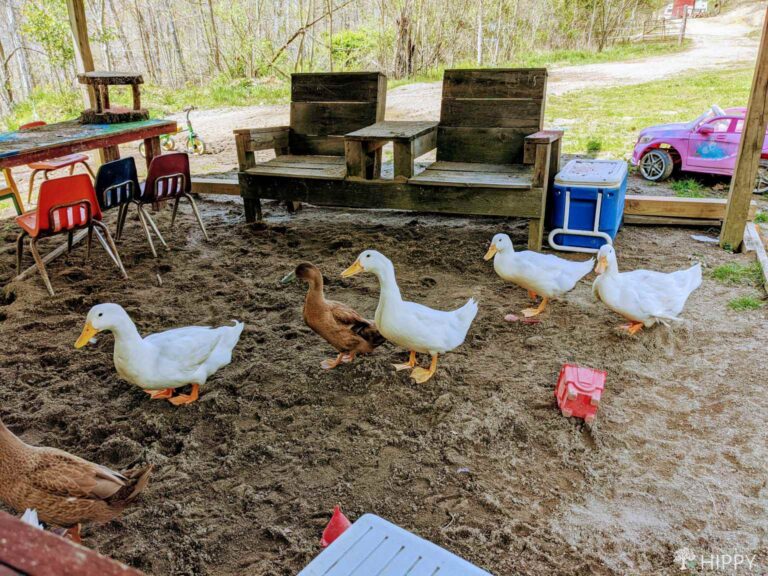
But for me and probably also for you, the appeal of owning my own flock of ducks is strictly as pets. They are just so charming and beautiful, I enjoy just having them around and taking care of them. If that’s how you feel, you’ve come to the right place.
But picking a breed that is suitable for keeping as a pet, versus pure production, requires a different approach and different insights into duck behavior and temperament.
But you don’t need to worry about that because I’m here to help with a guide on the 12 best pet duck breeds, and 5 you should probably think twice about. We’ll get right into the list below…
Pekin
The single most ubiquitous domestic duck in North America and around much of the world, Pekins are notable for being big, beefy, and very friendly.
They’re also very available, and you can get them from any hatchery, many pet shops, and most livestock supply stores when eggs are in season.
There is a lot to love about Pekins as a good first duck, but they do have some notable drawbacks you need to be aware of.
For starters, they’re some of the biggest ducks around and that means they need more room in and outside compared to other breeds. They also tend to be less healthy compared to other breeds, which might necessitate more medical care.
Regrettably, Pekins are also ducks with a short lifespan, with some only living 5 years and the largest among them, the so-called “jumbo” Pekin varieties, often not even living that long!
This, obviously, can be heartbreaking if you are attached to your precious birds. You might love them to pieces but it’s not a relationship made to last.
Saxony
A truly inspired choice for a pet duck, and one that I’m sad you don’t see more often, these big and highly productive egg layers have a gorgeous, unique coloration consisting of a rusty breast, white and gray flanks and back, and a slate-gray head set off by an orange bill. They truly are as pretty as a picture!
Saxonies also tend to be very calm, easy to handle, and fairly friendly as long as they’re raised with plenty of human interaction.
They are slow-growing, long-lived, and healthy, and the slow overall pace of their lives makes them a perfect pet that can go the distance with you. And, not for nothing, they will look good doing it the entire time!
Silver Appleyard
Silver Appleyard ducks are big, beautiful, very friendly, and exceptionally independent, making them a breed that won’t require constant babysitting from you, and this can definitely be a comfort to first-time keepers.
If you have a large yard or property that is rich with grass, plants, and insects, Silver Appleyards can provide much of their own food because they are such good foragers.
These ducks are also highly productive, so if you want plenty of eggs along with companionship they will definitely deliver. However, females tend to be pretty variable in terms of production, usually yielding anywhere from 100 to 250 eggs yearly.
Still, that’s plenty to keep your fridge stocked at the very least! They also tend to be remarkably healthy, meaning these big birds will rarely get sick.
Australian Spotted
One of the few domestic breeds on our list that was developed solely as a pet or ornamental bird, the Australian Spotted is tiny, rarely weighing more than just two pounds.
These birds are known for toughness and good health, and they rarely if ever get sick, and they also tend to enjoy a long lifespan.
They’re active, energetic, and, worryingly, can often fly meaning you’ll need to take steps to keep them grounded or contained.
They also tend to be a little on the noisy side, and their rarity means that finding them in the first place, much less affording them, is a challenging proposition. The payoff? One of the most charming and entertaining ducks you could possibly own!
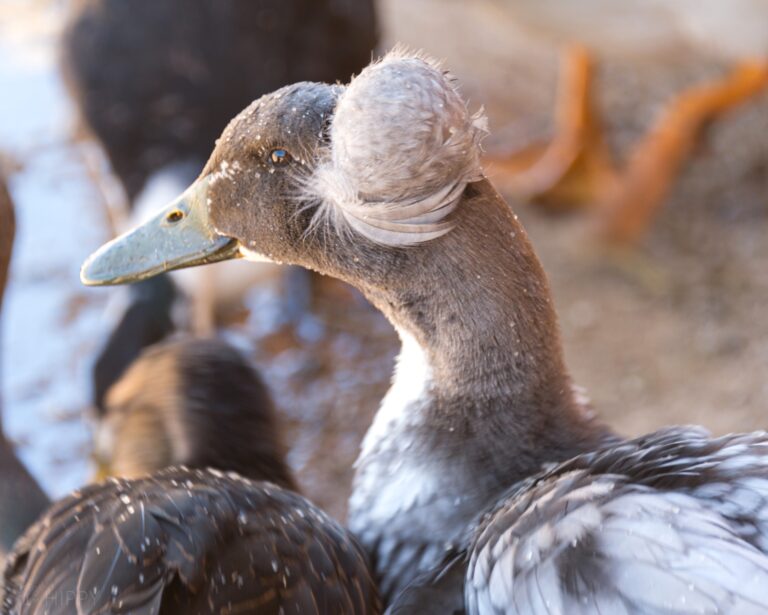
Blue Swedish
A rare heritage breed that has much to recommend it as a pet duck, the gorgeous, ashy-blue feathers of the Blue Swedish make it a constant competitor at expos and in poultry shows, and for good reason.
This large breed is, strictly speaking, a utility duck kept for meat and eggs, but they make remarkably carefree backyard flocks: though they need a little more space compared to others, they’re excellent foragers, incredibly healthy, and very tolerant of harsh weather, particularly extreme cold. They’re also famously docile and easy to handle.
Perhaps the only downside is their rarity, meaning you’ll have to work harder to find a good breeder or hatchery, and you’re going to pay more for ducklings or adults. As far as I’m concerned, it’s money well spent!
Cayuga
Probably the single most striking duck on our list, the Cayuga is known for its magnificent, jaw-dropping beetle-green coloration from front to back, consisting of a dark iridescent emerald and royal blue, punctuated by black. Truly, you won’t forget these beauties!
Many duck fanciers keep Cayugas for their physical appeal alone, but they actually have a lot more going for them than that.
They are very quiet compared to most other breeds and are generally incapable of flight meaning they aren’t hard to contain. They are reasonably calm, but I wouldn’t describe them as overtly friendly.
Raised right, they won’t mind interacting with you, but they don’t like a lot of physical touching and definitely don’t like to be picked up as a rule. As long as you are okay with giving them a little space, Cayugas won’t give you any problems.
Buff Orpington
Possessing a gorgeous, even tan or buff coloration, Buff Orpingtons are well-regarded for their calm demeanor, self-sufficiency, and good laying capabilities. Oh, and they don’t fly, meaning escape attempts will rarely be successful as long as you have even a modest fence to keep them in.
Just as popular as an egg-laying breed as they are for pets, Buff Orpington ducks are remarkably good mothers meaning that if you want to expand your flock the natural way, they can take care of it for you.
However, compared to the chickens that share their name, Buff Orpington ducks are rare and tend to be pricey, and there are plenty of shysters out there selling hybrids. You’ll have to spend more with a good hatchery to get one of these ducks for sure.
Welsh Harlequin
When it comes to the pure joy of keeping a duck, it is very difficult to beat the Welsh Harlequin. And despite what their name might suggest, these ducks aren’t mischievous or pranksters.
They tend to be really calm. Incredibly calm, in fact, and they are known to be very friendly with their human keepers. If you like getting up close with your ducks for interaction, pets, and cuddles, the Welsh Harlequin is one of the very best breeds around.
Even better, they don’t fly at all, and if you want duck eggs you’re going to get plenty in the bargain: healthy hens will lay upwards of 240 yearly, with some exceptional layers meeting or exceeding 300.
And when it comes to the noise factor, Welsh Harlequins are average or even a little below average. They aren’t silent, but neither are they around-the-clock noise boxes like some other good pet breeds on our list. One of the very best around, don’t hesitate to get your own flock!
Hook Bill
The Hook Bill, sometimes referred to as the Dutch Hookbill, is instantly recognizable by its unique bill shape which has a slight, shallow downward curve.
This definitely sets them apart from other domestic breeds, but the bill is not a deformity: it actually helps make these beautiful birds stupendously good foragers, and if your land is bountiful with bugs and choice bits of plants, they can provide much of their own food.
This excellent self-sufficiency is one of the best attributes they have as a pet, and they are also known for an even, typically calm temperament.
Interestingly, they are also one of the most ancient known domestic breeds, and writings confirming their existence go all the way back to the mid-17th century, and they were certainly around before then.
These ducks are truly remarkable, but unfortunately, they are critically endangered: they were nearly extinct by the end of the 1980s, and only since the early 2000s have they started to rebound, if only slightly. Do your part to help bring this breed back from the brink by getting some of your own!
Call
One of the tiniest and cutest ducks on our list, the Call duck has an interesting history. They were originally bred, and kept, to aid hunters in drawing wild ducks closer to them during hunting expeditions.
That’s because the tiny Call is quite a talker, making a loud, constant, and piercing call that other ducks would readily respond to.
They aren’t used for that so much these days, but they have lived on as an ornamental and pet breed and it’s obvious to see why. These tiny, plump, precious ducks look very much like a little cartoon or stuffed animal come to life, and they have friendly personalities to boot.
But, I warn you: these are the noisiest ducks there are, and they are noisy around the clock. Though they are so petite they tend to be fragile, so you must be cautious when handling them.
Black East Indie
The Black East Indie, sometimes just called the East Indie, is an uncommon breed but one that’s well known among duck enthusiasts for its prominence as an exhibition bird.
These gorgeous ducks have an iridescent green from tip to tail that is broken up by charcoal black feathers on the breast, wings, and underside. They really are lookers!
They’re also calm, quiet, hardy, expert foragers, and very diligent mothers, meaning growing your flock will be a cinch with them.
The only downsides? Aside from their relative scarcity, they are very broody, meaning a regular egg supply is going to be unlikely if you care about that, and they tend to be pretty good flyers, meaning containment can be an issue if you don’t clip wings.
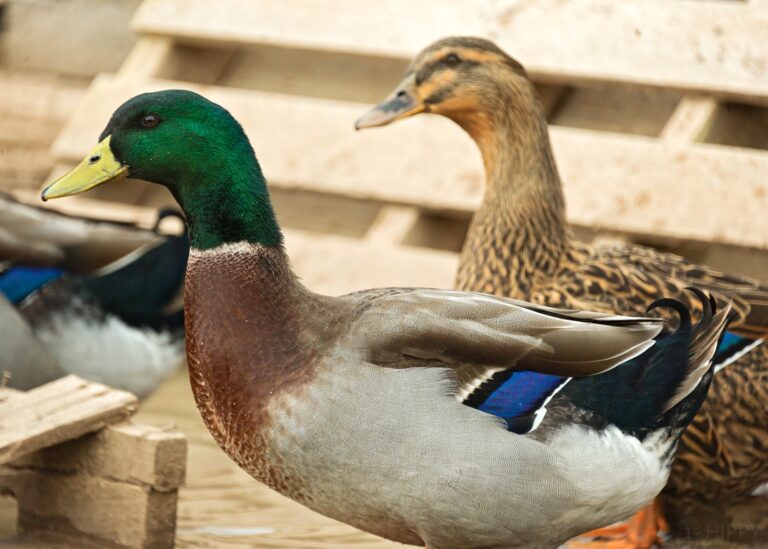
Rouen
Rouens are one of the biggest ducks around, and very popular as ornamental birds because of their impressive size, gorgeous feathering, and stoic demeanor.
If you want your ducks to stay nearby, these beefy birds are one of the very best because they tend not to roam and forage as much as other domestic breeds because of their sheer girth.
Despite their size, they are remarkably easy to handle because they stay calm and unruffled no matter what’s happening. Raise them with even a little bit of socialization, and it will be smooth sailing from then on.
Despite these excellent qualities, there are some downsides you need to know about with Rouens. They’re so big they tend to get injured easily, especially when hopping down or accidentally falling.
Bumblefoot is a major concern to be on the lookout for. And compared to most other ducks on our list, they need more access to water and more space, necessitating a larger pool or pond for them to thrive. As long as you can accommodate these issues, Rouens will treat you right.
5 Duck Breeds that Don’t Make Good Pets
There are lots of great domestic duck breeds out there, but the following five aren’t among them. You might be able to make great pets out of them depending on your desires and situation, but I’d recommend you think twice before you commit to any of them.
Mallard
The mallard duck has the distinction of being one of the most common and iconic in the world, and they are found in both wild and domesticated varieties.
In fact, pretty much all domestic ducks descend directly from mallard stock! You might say they are the original domestic duck in some regards.
Unfortunately, even the domestic variety tends toward wildness. They are skittish, standoffish, and drakes can often be highly aggressive, as can hens when they are feeling broody which is often.
They’re also good flyers as a rule, meaning you’ve got to stay on top of clipping wings or keeping them in a covered run. They can still make a fulfilling flock for your backyard or homestead, but they aren’t for inexperienced or impatient keepers.
Indian Runner
One of my personal favorite domestic species, the Indian Runner is instantly recognizable for its upright, penguin-like body and extreme ground speed. They don’t fly, but they really do run!
Although their antics make them fun to watch, they need lots of room, tend to be hyperactive, and are prone to nervousness and flightiness. A flock of Indian Runners that gets spooked can stampede, injuring your birds as they bang into each other and obstacles.
You can raise them to be trusting and friendly, but this is a lot of work compared to the other breeds on our list. Think twice!
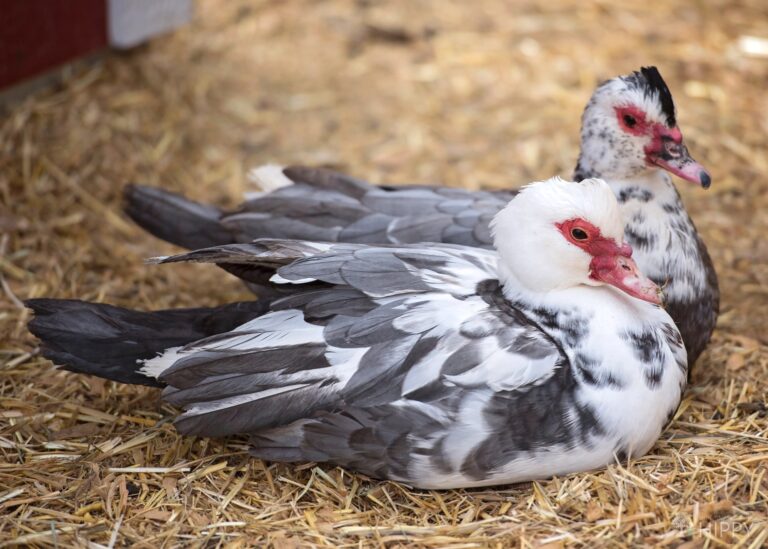
Muscovy
Muscovies are a large and physically impressive domestic breed that’s distinct from the mallard lineage, making them relatively unique. But like the mallard, there are domesticated, and wild Muscovy flocks that are basically interchangeable in terms of appearance and, sadly, temperament.
You have to keep an eye on them because, despite assurances, they can often fly, especially in the case of lighter males and females, and they are also physically powerful, a concern since they have substantial talons on the end of each toe that they use to climb and roost in trees.
They can be a handful in more ways than one! Plus, they hiss instead of quack, and that can be downright unsettling!
Khaki Campbell
I know some folks are bound to raise an eyebrow at the inclusion of the Khaki Campbell in this category because they’re one of the most beloved and well-regarded domestic breeds on earth.
If you want eggs, nothing beats a Khaki Campbell, as they can lay upwards of 300 each and every year like clockwork.
Unfortunately, Khaki Campbells tend to be a little neurotic. They are easily startled and seem to have a hair-trigger temper in some circumstances, resulting in your otherwise tame duck turning on you in a temper tantrum.
They’ll calm down, of course, but this makes them something of a liability if you are a nervous keeper yourself or if you have small children.
Magpie
Magpie ducks are another popular domestic that’s going to leave some readers scratching their heads. They have a good temperament, they tend to be healthy, and they are even good egg layers. So what gives? Why are they bad pets?
The problem, for most of us, is that magpies tend to be highly active and inquisitive, and they need lots of room to stretch their legs and get exercise. And I mean on land and on the water!
Their space requirements are substantial compared to most other domestic ducks of their size, and these space concerns are compounded if you want a larger flock. If you have the room, go for it, but if you don’t, I urge you to look at a different duck.
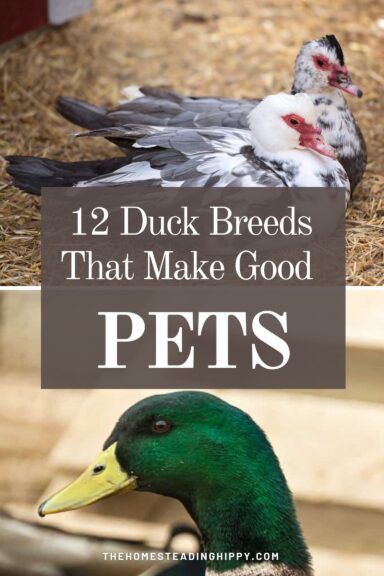
Tim is a farm boy with vast experience on homesteads, and with survival and prepping. He lives a self-reliant lifestyle along with his aging mother in a quiet and very conservative little town in Ohio. He teaches folks about security, prepping and self-sufficiency not just through his witty writing, but also in person.
Find out more about Tim and the rest of the crew here.
